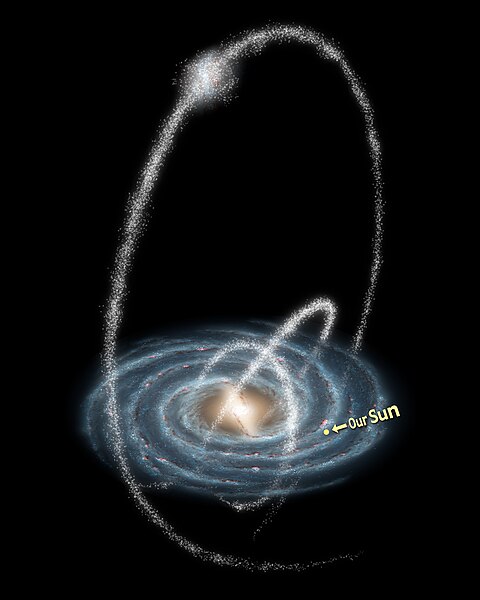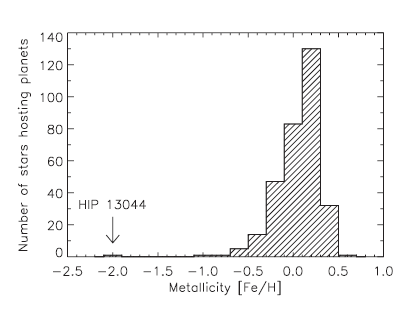On Thursday, November 18th, astronomers reported in Science Express that they had found the first extra-solar planet, called HIP 13044 B, that originated outside of the Milky Way galaxy. It's actually part of our galaxy now, but it originated in a galaxy that the Milky Way cannibalized, that is, ripped apart and absorbed.
Now, how can we possibly tell that this planet is of extra-galactic origin? Because of the great distances involved, the 500-something extrasolar planets discovered so far lie within a few hundred light-years of the Earth. (Though some people at UofT think they might have found a way to find planets in other galaxies.) However, the movement of HIP 13044, the star around which this planet revolves, seems to indicate that it's part of the Helmi Stream, a long string of stars which has been tidally distorted and pulled to form a loop around the galaxy. Numerical simulations and observations seem to indicate that each tidal stream around our galaxy used to be a dwarf galaxy or globular cluster that was pulled apart by the Milky Way. Here's a pretty artist's rendition of tidal streams from Wikipedia:

There are a couple of other peculiar things about this newly-discovered planet. The first is that the host star, HIP 13044, is extremely low metallicity, which means it contains very few heavy elements. In astronomy terms, heavy elements are any element heavier than helium, such as carbon, oxygen, up to iron. Anyway, this star has the lowest metallicity of any planet-bearing star discovered, at about 1% of the sun's metallicity. This is remarkable because the metals within a star are thought to be essential to the formation of planets, and this star having so little of them seems to challenge our knowledge of planet formation. Looky! A graph showing this star's metallicity compared to other stars that host planets:

The other peculiar thing is that the host star is in its red giant phase, which means that it has stopped fusing hydrogen into helium at its core, which causes it to become bloated and red. When the sun enters this phase, it will expand beyond Earth's orbit, totally destroying our planet. But don't worry, this won't happen for a few billion years. Here's a pretty picture of the life cycle of our sun from Wikipedia:

So if HIP 13044 is in its red giant phase, it might have engulfed other planets in the system that were closer in, and in fact, the higher than expected rotation rate of the star seems to indicate that this did indeed happen. In addition, it looks like the planet HIP 13044 B might be about to fall into the star itself as it enters its next phase of red giant expansion.
Finally, this planet was found using the radial velocity method of detection. In a nutshell, the presence of a planet around a star will cause it to wobble in its orbit. Because of the Doppler effect, as the star wobbles towards us, its light is slightly blue-shifted, and as it wobbles away from us, its light is slightly red-shifted. Here's a nice little animation, again from Wikipedia:

From the wobble of the star, we can tell that the planet has a mass at least 1.25 times that of Jupiter and an orbital period of 16.2 days. And it isn't Monday anymore. Darn.
Love the post! Here's to Science! Cheers!!
ReplyDeleteI like how the "Life cycle of the sun" chart is "not to scale".
ReplyDelete